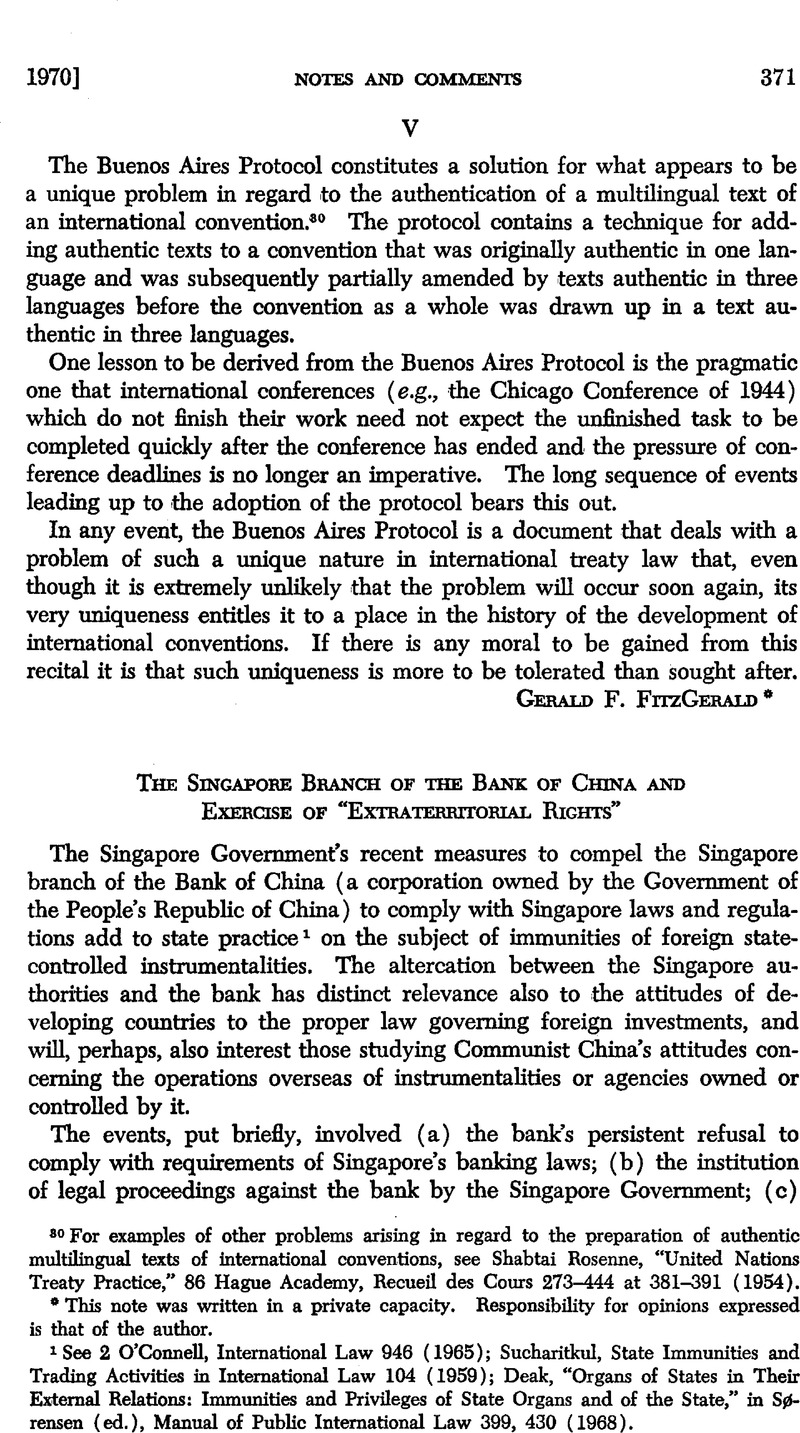No CrossRef data available.
Published online by Cambridge University Press: 28 March 2017

1 See 2 O'Connell, International Law 946 (1965); Sucharitkul, State Immunities and Trading Activities in International Law 104 (1959); Deak, “Organs of States in Their External Relations: Immunities and Privileges of State Organs and of the State,” in S0- rensen (ed.), Manual of Public International Law 399, 430 (1968).
2 The notices were issued under S. 22A(1) of the Banking Ordinance 1958 (Federation of Malaya Ordinance 62/58 made applicable to Singapore when Singapore was part of Malaysia, and modified by Modification of Laws (Banking) Order, 1967). S. 22A(1) reads: “(1) The Commissioner may, from time to time, with the approval of the Minister, prescribe by notice in writing to each bank a minimum amount or amounts of liquid assets to be held by the bank;“
3 The explanation for the prescribed ratio was put thus: “Besides being able to meet day-to-day transactions, the funds could also provide for unexpected withdrawals. This provision would also prevent unrestrained credit expansion which can gravely jeopardise the interest of the depositors … the bulk of the depositors are Singapore citizens and the law takes into account their interest and welfare.” Statement made in court by Singapore's Banking Commissioner. The Straits Times (a daily Singapore newspaper), May 15, 1969.
4 The Banking Commissioner revealed that surprise checks on banks showed that several other banks were also found guilty of not maintaining the ratio, but these banks took corrective action immediately. Straits Times, May 15, 1969.
5 Prosecution was instituted under S. 22 1(1)(a) of the Banking Ordinance under which failure by a bank to comply with any such notice constituted an offense. The Judge was the Honourable Mr. D. C. D. D'Cotta, District Judge and First Magistrate.
6 That is, $1,000 a day for each of the 128 days that the bank was found not complying with the ratio. This was the maximum sentence.
7 S. 267 of the Criminal Procedure Code provides, inter alia, that in every case where the offender is sentenced to pay a fine, the court may at any time before the fine has been paid in full “issue a warrant for the levy of the amount by distress and sale of any property belonging to the offender.“
8 Synn Lee & Co. Ltd. c. Bank of China, [1962] Malayan Law J. 395: The bank never indicated it was waiving an immunity which it enjoyed. The bank has also sued in local courts: Bank of China v.Lee Kee Pin, [1961] Malayan Law J. 40; Bank of China v.Chew Kean Khor, [1963] Malayan Law J. 41.
9 In a letter to the writer, the Sub-Manager of the bank claimed that the legal proceedings “served only as a means to an end in the political persecution against our Bank.“
10 The only reported local municipal decision on the commercial activities of foreign sovereign entities and the problem of immunity is the 1834 case of Abdul Wahab bin Mohd. Alii v.Sultan Alii Iskander Shah, (1834) 1 Kyshe Reports 298, which held that a foreign sovereign prince who remains in the country for a protracted time and engages in mercantile transactions (such as borrowing money in his private capacity on a promissory note) is liable to be sued thereon in local courts and cannot claim immunity on the ground of his sovereign status.
11 Ministry of Finance Statement of May 18, 1969. Straits Times, May 19, 1969.
12 These other violations were enumerated: “The Bank refused to attend Court in the recent trial and ignored the summons served on it. This is an offence under Section 174 of the Penal Code. The Bank refused to comply with certain directions legally issued by the Commissioner of Banking, thereby offending against Section 19(D) of the Banking Ordinance. The Bank refused to make available to officers of the Commissioner of Banking books for inspection. This is an offence under Section 186 of the Penal Code. The Bank had submitted false information … thereby breaching Section 477 A of the Penal Code… .“
13 The Straits Times of May 18, 1969, gave the following account: “The Bank of China was packed to capacity today [May 17] as hundreds of people jammed its premises to hear ‘political broadcasts’ over its public address system for the second day running. Armed police stood by inside the Bank while detectives mingled with the shoulder-to-shoulder crowd. More posters were pasted on the wall. The broadcast went on at regular intervals. Another new development inside the bank was a signature campaign by ‘supporters.’ Many supporters signed their names on a long length of silk cloth placed over a large table. Among the signatories were young Chinese educated girls.“
14 A Reuter report from Hong Kong stated that Communist Chinese banks in Hong Kong were ordered by Communist China to give unlimited support to the Bank of China and to “make sure it survives the present crisis,” and these Hong Kong banks were also reported to have supplied “tens of millions” of dollars of credit to the bank in Singapore. Straits Times, May 24, 1969.
15 Ministry of Finance Statement, May 18, 1969. Straits Times, May 19, 1969. The bank, in its political broadcasts, maintained that “No one had the right to close down the bank, which is a corporation owned by the Chinese Government.“